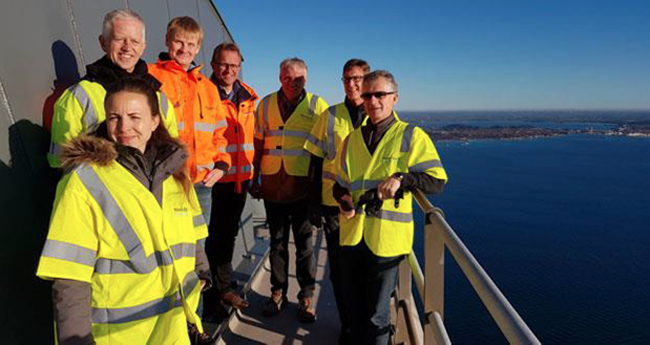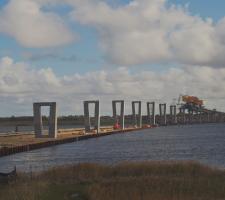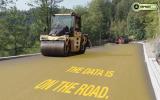
Denmark, being a country mainly of islands, relies on its bridges and tunnels to help unify the nation culturally. It also means that they are vastly more important to the economic well-being of the nation than in most other states.
The
For this reason, Denmark’s bridges have a higher degree of importance relative to the country’s economy than bridges in a lot nations, European or otherwise.
However, the country’s population of around only six million means that it has a low tax base from which it must earmark the millions of Danish krone needed to maintain some very impressive road and rail bridges. Also, only two of these road bridges are tolled, further limiting financial resources that can be put towards bridge maintenance, or in some cases replacement. Given these hard facts, good asset management has been essential for keeping the nation’s bridge infrastructure fit for purpose.
For this reason, the man in charge of asset management has spent an engineer’s lifetime refining such systems, although not always for bridges and not always in Denmark.
Niels Pedersen, 62 years old and a civil engineering graduate from Denmark’s University of Odense, has been with Vejdirektoratet - Danish Road Directorate - since 2014. Vejdirektoratet is responsible for the 4,000km network of motorways, a number of main roads and many of the country's bridges.
After graduating, Pedersen found himself working first in electrical distribution and had stints outside Denmark in Africa, notably Sierra Leone, and in Greenland, a Danish protectorate. He was also heavily involved at senior management level in merging two power distribution companies to help create Energinet, the Danish national transmission system operator for electricity and natural gas.
“I was coming back to my roots because I studied civil engineering [at Odense] and was supposed to have been building bridges,” he says. “I don’t think it has been so difficult moving from power distribution to bridges. As an engineer I was always fond of statistics.”
State-owned
Very nearly all bridges in Denmark are state-owned. The directorate operates 5% of motorways but carries 50% of traffic. “So if you don’t maintain these bridges and motorways the country would literally break down,” says Pedersen. “Trucks carry around 92% of all goods in Denmark. Meanwhile, 6% goes by ship. So we are extremely dependent on major roads and bridges.”
Denmark has no public-private bridges. For every new bridge built, the government must put in law the amount that the bridge will get for maintenance, meaning there is a legal guarantee for the finance.
With roads and bridges so critical to Denmark’s economy, the government strategy is to connect its islands and peninsulas such that should one bridge be out of commission for any reason then traffic can find its way via another bridge. “That is because I’m so used to thinking in terms of redundancies from my power distribution background,” he says.
“My main focus right now is continuing our tradition for high-quality maintenance and inspection regimes. We were very early adopters of having a bridge asset register and have more than 30 years of data. We have more than 10,000 bridges in total. But that includes our own [highways directorate’s] as well as bridges owned by the rail operator DSB amounting to a couple of thousand and then we have the local authority bridges.”
A major detailed general assessment inspection takes place every six years where the situation is ranked from zero to five and “five is where you have to absolutely do something”. In between these inspections, there are many routine safety inspections and at least one overall inspection a year, he explains.
His department also produces a yearly asset management report - it used to be every fourth year. “If we see any issues, then we will do destructive testing such as pulling out concrete samples.” The information is loaded into the bridge asset management database.
However, the system is getting less upgradeable as time goes by. Pedersen says the directorate is looking to migrate its data to a new asset management system. Also, with the increasing use of BIM – building information modelling - a new asset management system will have to accept data downloads and produce 3D detailed drawings.
“Today we are often still going out to inspect bridges with pen, paper and camera. But future inspections could be from an office desk with information instantly available from drone flights in far off places.”
Sensors
Much of this data collection might rely on sensors that are embedded during construction. Some of these are for measuring the curing progress of concrete for pylons and other substructure elements. Other sensors could be for longer term data collection for trusses, anchors and steel lattice work.
This sensor technology is developing, he says. But Pedersen is cautious about the extensive use right now of such devices. They are not always the best value for money. Cathartic protection, however, is much more a proven technology and that exists in some Danish bridges.
New-build and sometimes extensive renovation require environmental impact assessments and Pedersen believes Denmark is in the forefront of good practice. “The process in Denmark is fast for environmental assessments. The assessment still fully details a project but it simply assesses the project relatively quickly.”
An example of innovative thinking brought about by an environmental assessment is the Roskilde Bridge, a 1.3km-long concrete bridge over Roskilde Fjord between Marbaekej and Torslev Hage. Completion is expected by the end of this year (see World Highways, Key Project Report, Nov/Dec 2018).
The bridge is part of an 8.2km-long four-lane motorway connecting the eastern and western shores of the fjord. The substructure of this bridge includes 16 piers as well as two abutments, all of which are now complete. Three of the 16 piers are supported on shallow foundations, while the rest are on bored piles, four per pier. The offshore work required the construction of a temporary harbour for the maritime resources, while the onshore piles required temporary embankments built on both sides of Roskilde Fjord.
For the project, it was less environmentally disturbing to truck in prefabricated deck sections from Poland than create a concrete plant on site which would have required more farmland to be withdrawn from use and possibly more collateral pollution, not to mention noise for the many local inhabitants.
“You are also building very close to the village where there are a lot of summer houses.” Silent pile-driving was done for the most part to keep noise down. When the project is finished, the contractors will have to realign the river banks to their prior positions as an aid for migratory birds and also to recreate the fjord walk that is being disrupted by construction work.
The flip side has been Denmark’s struggle with getting environmental approval from Germany for the massive Fehmarn Belt connection, which is admittedly more important for Denmark than Germany. The Fehmarn tunnel is an 18km immersed combined road and rail link connecting the Baltic Sea regions of Germany and Denmark. It features a four-lane motorway and a double-track electrified rail line. A 17.6km immersed section will be by far the longest immersed tunnel in the world.
“If you compare [Roskilde] with the Fehmarn project, it is very tricky to get environmental issues sorted and permissions in Germany than in Denmark. Even though Denmark is paying for the bridge while Germany is paying for connecting routes to the tunnel, it’s much more political an issue in Germany.”
Apart from economic importance, bridges also can be culturally important, gaining iconic status. Such is the case with the Storebælt Bridge, an 18km link connecting the eastern and western parts of Denmark. It is also one of the very few bridges in Denmark for which Vejdirektoratet is not directly responsible, notes Pedersen. Holding company, Sund & Bælt, owns the shares in A/S Storebælt, which is responsible for the finance, operations and maintenance.
The road and rail Storebælt Bridge is, in fact, two bridges – the East and West – plus an undersea tunnel. The East Bridge between Zealand and Sprogø is nearly 7km long and comprises a 2.7km long suspension section. The suspension bridge consists of the 1.6km span between the two pylons plus the two side spans between the pylons and anchor blocks of 535m each.














